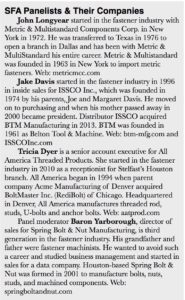SFA Panel: U.S. Tariffs Hiking Steel Prices
BTM Manufacturing received two loads of steel over a three-week period with price increases of $0.04 per pound on each load.
Southwestern Fastener Association panelists agreed steel tariffs are not creating jobs – just price increases. The panel on “Past, Present & Future” featured SFA members representing different age groups.
“The steel industry is taking advantage of it,” BTM president Jake Davis opined.
Supporting the domestic steel industry does not create many jobs, panelist John Longyear of Metric & Multistandard observed. The steel industry is heavily automated, Longyear explained. Where there used to be 100 working in a steel mill, today there can be 30 or fewer.
 Tricia Dyer of All America Threaded Products agreed that domestic steel mills are upping prices “because they can.”
Tricia Dyer of All America Threaded Products agreed that domestic steel mills are upping prices “because they can.”
Panelists doubted steel tariffs will change the fastener industry.
“Nuts aren’t made here and they are not going to be,” Longyear observed. The exception would be special production runs.
Longyear, a 46-year veteran of the fastener industry described doing business in the 2018 economy: “If you can run fast, you can make the sale.”
“There was no ‘online,’” Longyear recalled of his start in the industry in 1972 with Metric & Multistandard. It was long before faxing too, he added.
“Nobody had computers. You ran back and forth in warehouse and physically looked at shelves for inventory.”
Longyear recalled there were only three companies selling metric fasteners when he started: Zelenda, Veteran Tool & Supply and Metric & Multistandard. All three were New York based. Metric was a niche industry with 80% of sales to end users.
“Distributors didn’t want to touch metrics,” Longyear explained. Today distributors “can’t not sell metrics.”
Nor was there an Amazon.com not-so-many years ago. “Everybody is affected,” declared Davis, who is with manufacturer BTM and distributor ISSCO Inc. It makes traditional fastener distributors a “niche business.” It is increasingly easy for commodity buyers to just go online and click to buy, Davis said.
However, Dyer finds that contractors have not moved en masse to Amazon and remain buyers from distributors.
• Tips to attract millennials include offering more than a job. “People want growth,” Dyer said.
“Does your company have a plan for the future?” Longyear asked. “This is not a glamour industry even though it holds the world together.”
“It is easy to get stagnant,” Davis warned.
Each generation is new, Davis observed. There were Baby Boomers (1945-1964), GenXers (1965-1980) and now Millennials (1981-1996) in the workforce.
“Everyone was a new generation,” Davis noted.
Millennials are so computer data oriented, Dyer observed. Today customers can see what time thread is being cut on what machine, she pointed out.
That customers can look at inventory online “makes you a better salesperson,” Longyear suggested.
It means companies need to keep up with their websites. Longyear, noting he may be the oldest manager in the room, said he pushed for an upcoming Metric & Multistandard website.
Your position on a Google search is vital, Longyear said. Customers “will never get down to twentieth.”
• Baron Yarborough of Spring Bolt & Nut Manufacturing mentioned the fast growth of online ordering. It wasn’t many years ago when his predecessor, Tim Malone, told him he doesn’t need emails because orders come in over the fax machine.
• Acquisitions will continue to be a part of fastener life. Davis said the “easiest way to beat the competition may be to buy them.”
Recalling the ‘Mom & Pop’ history of the industry, Davis advised distributors ”we just have to pivot” to stay in business. An advantage of consolidation is that “the fear of consolidation should make us better.”
Dyer noted that some smaller companies that are not doing well may be improved by acquisition.
Longyear noted not just companies have been changed by acquisitions. Associations feel the difference too. Longyear, a longtime SFA board leader, recalled there were more than 100 distribution companies a generation ago.
“People who remain independent want to be,” Longyear noted. “They’ve had offers.”
• There is still a role for personal sales, the panelists agreed.
“People still buy from people,” Dyer observed, though she acknowledged the Internet and other factors are decreasing “brand loyalty.”
“I’m a business relations guy,” Davis declared. “Get in front of people and build relationships.”
By getting out to industry events, “You can get great connections,” Yarborough said.
• Today’s biggest challenge is “educating those new to the industry,” Dyer said. She advocated sending new employees to Fastener Training Institute courses.
Taking FTI courses “opened my eyes as to what fasteners are.” Before they were just products in boxes, she acknowledged.
Have new employees go see manufacturing and plating facilities so they understand fasteners, Dyer urged.
In calling for more training, Davis said he finds many fastener “buyers know only part numbers.” Associations need to take new roles in providing training, he added.
“How many people go to college to sell bolts and nuts?” Longyear asked. A broader discipline of “industrial distribution” is what they are studying.
You and your staff people need to “ask questions and listen to the answers,” Davis advised.
Longyear agreed and recalled Metric & Multistandard started him in the warehouse to learn actual parts.
Though the panelists were talking about industry changes, Longyear observed that for all that has changed, the majority of products he handles are identical to when he entered the fastener industry in 1972.
For information contact SFA executive director John Elsner. Tel: 713 952-5472 Email: swfa@swbell.net Web: sfa-fastener.org
From the Fastener History section of GlobalFastenerNews.com: 2010 – Southwestern Fastener Association History and Officers
For more news on the fastener industry, click here.


There are no comments at the moment, do you want to add one?
Write a comment